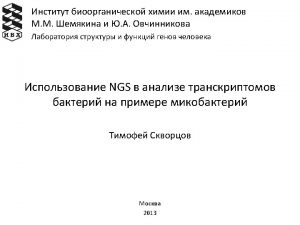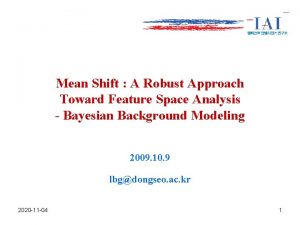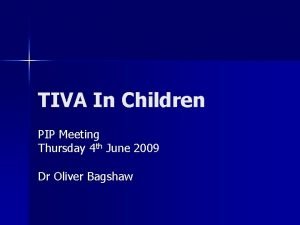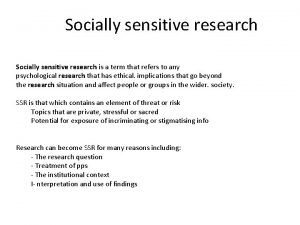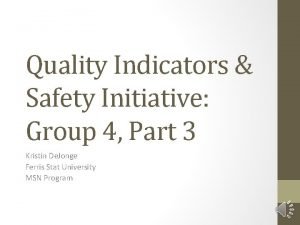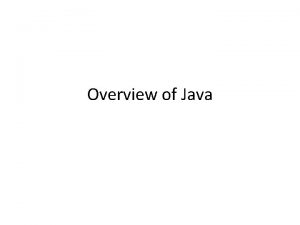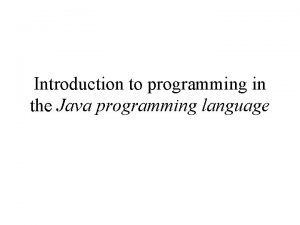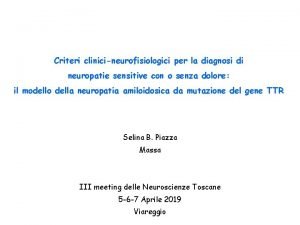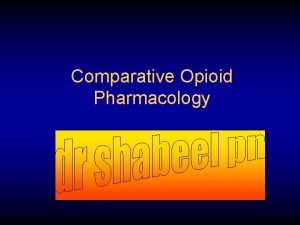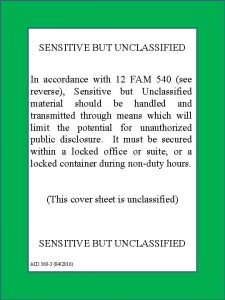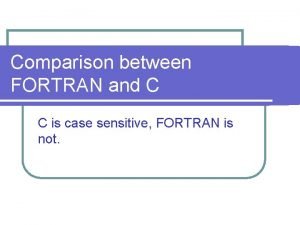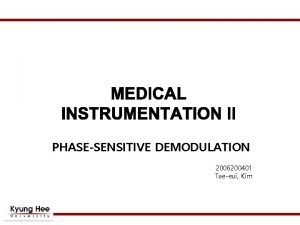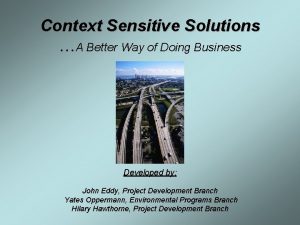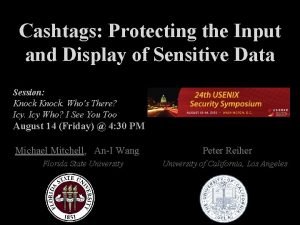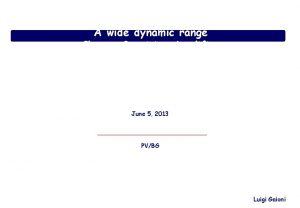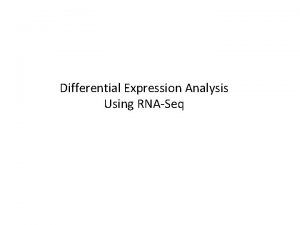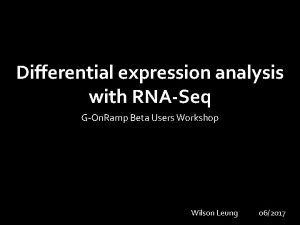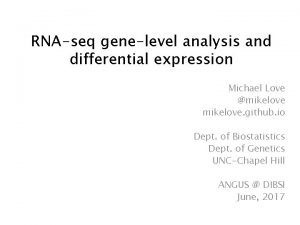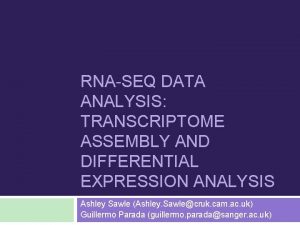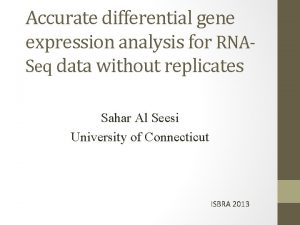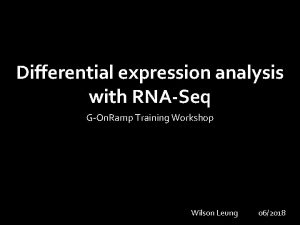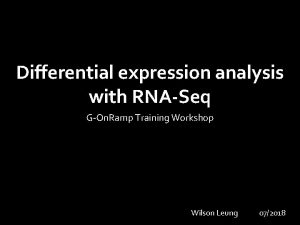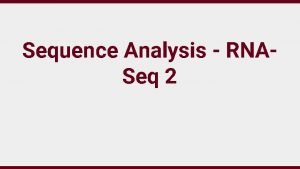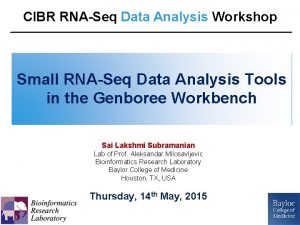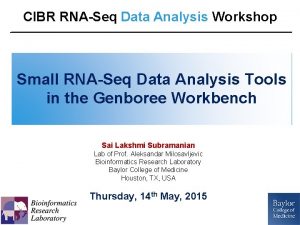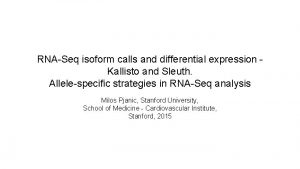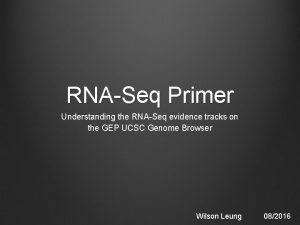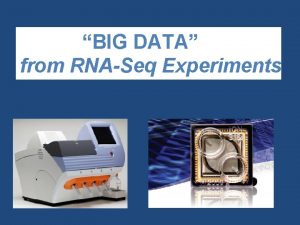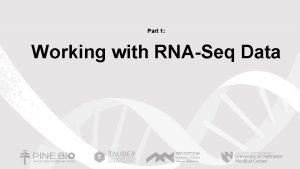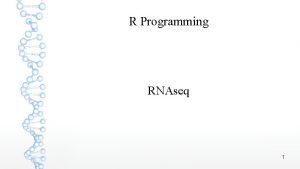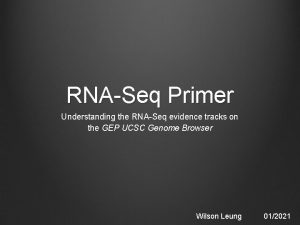Toward More Sensitive Differential Expression Analysis on RNASeq










































- Slides: 42

Toward More Sensitive Differential Expression Analysis on RNA-Seq Data Tao Jiang Joint work with Ei-Wen Yang (UCR/UCLA) and Thomas Girke (UCR)

1 /43 Outline • Biomarkers, Gene Expression and RNA-Seq • Incorporation of Coexpression Data (MRFSeq) • Expression Features Sensitive to Alternative Splicing • Transcript-Based Differential Expression Analysis on Population Data with Unknown Conditions (SDEAP) • Experimental Results

2 /43 Biomarkers and Expression Analysis • Recent advances in DNA/RNA sequencing and microarray technologies have helped identify many genetic, epigenetic and transcriptomic biomarkers for diseases/health issues: *lung cancer *pancreatic cancer *ovarian cancer *oral cancer *cardiovascular disease *Huntington’s disease *depression *Alzheimer’s disease *aging *liver transplant tolerance • Differential expression analysis (with or without given conditions) is critical to the discovery of biomarkers • Precision medicine will drive up the demand for more sensitive biomarkers and hence differential expression analysis

3/43 Gene Expression • Gene Expression ▫ The synthesis of a functional gene product (i. e. , RNA or protein). • Measuring Expression Levels of Genes (i. e. , abundance of RNAs) ▫ Microarrays and RNA-Seq. ▫ RNA-Seq has been increasingly used because of its high reproducibility and sensitivity. Mortazavi et al. (2008) Mapping and quantifying mammalian transcriptomes by RNA-Seq. Nature Methods 5, 621 -8 Marioni et al. (2008) Rna-seq: an assessment of technical reproducibility and comparison with gene expression arrays. Genome Res 18(9), 1509– 17

4/43 Differential Gene Expression Analysis • Differential Gene Expression Analysis ▫ Identify genes that are expressed differently in biological samples of interest. • Importance of Differential Gene Expression Analysis ▫ As a fundamental tool for discovering genes involved in a disease or biological process, differential gene expression analysis plays an important role in genomics research with many applications in systems biology.

5/43 Differential Gene Expression Analysis • Differential Gene Expression Analysis ▫ Identify genes that are expressed differently in biological samples of interest. • Importance of Differential Gene Expression Analysis ▫ As a fundamental tool for discovering genes involved in a disease or biological process, differential gene expression analysis plays an important role in genomics research with many applications in systems biology. ▫ However, disease related genes are often not among the most differentially expressed. Hence, sensitive differential expression analysis is critical.

6 / 43 Overview of RNA-Seq Procedure Extract all RNA molecules ? ? ? ? ? ? ? ? ? ? ? ? ? ? ? ? ? ? ? ? ? ? ? ? ? ? ? ? ? ? ? ? ? ? ? ? Prepare a library of c. DNA fragments AACGTT CTAACG TTAGCA ACCGAC ATGGCA TTGTCA CGCATG GTCACT Sequence fragments ? ? ? ? ? ? ? ? ? ? ? ? The reads may also have paired-ends. Wang, Z. et al. (2009) RNA-Seq: a revolutionary tool for transcriptomics. , Nature Revivew Genetics 10(1): 57 -63

7 /43 Read Alignment and Expression Level Gene A TTAGCA ACCGAC ATGGCA Gene B TTGTCA CGCATG GTCACT Gene C Gene. D AACGTT CTAACG The number of reads mapped/aligned to a gene is called its read count, which is often nearly linearly correlated with the expression level of the gene. One may also consider the expression levels of exons (exon-based analysis) or transcripts/isoforms (full transcript-based analysis) as expression features, to take into account alternative splicing. Mortazavi, A. et al. (2008) Mapping and quantifying mammalian transcriptomes by RNA-Seq, Nature Methods 5(7)

8/43 Problem Formulation Sample 1 Sample 2 Gene A 100 110 103 101 113 100 110 Differential gene expression analysis is to identify which genes are differently expressed (DE) or equally expressed (EE) between biological conditions of interest using observed read counts. DEGseq, GPSeq, DESeq, edge. R, NOISeq, bay. Seq, etc.

9/43 Difficulties • Statistical power decreases when the number of reads decreases. Sample A Sample B g 1 100 144 g 2 10 14 Given background noise, it may be more difficult to tell if g 2 is a DE gene. Long or highly expressed genes are more likely to be detected as DE genes. This selection bias against genes with low read counts may distort downstream analyses at the systems biology level.

10/43 Our Method: MRFSeq • Use coexpression data to enhance the statistical prediction power. • Probabilistic modeling with a Markov random field (MRF). g 1 ? g 3 g 4 DE genes g 2 g 5 EE genes Obayashi T. and Kinoshita K. (2011) COXPRESdb: a database to compare gene coexpression in seven model animals. Nucl. Acids Res. Wei Z. and Li H. (2007) A Markov random field model for network-based analysis of genomic data. Bioinformatics 23 (12): 1537 -44.

11/33 The (Pairwise) MRF Model x 3 x 1 x 2 x 4 The joint (a posteriori) probability distribution of x ’s (given read counts) follows the Boltzmann i i distribution: The maximum a posteriori (MAP) probability can be estimated by a fast max flow algorithm. Kolmogorov, V. and Zabih, R. (2004) What energy functions can be minimized via graph cuts? IEEE Transactions on Pattern Analysis and Machine Intelligence 26(2), 147 -159.

12/43 RNA-Seq read counts Compute prior probabilities by using DESeq or other RNA-Seq based tools Build a Markov random field (MRF) Coexpression network Estimate the MAP probability by using an efficient max flow algorithm Differentially expressed genes Yang EW, Girke T and Jiang T. (2013) Differential gene expression analysis using coexpression and RNA-Seq data. Bioinformatics 29.

13 /43 Transcript-Based Differential Expression Analysis Is More Sensitive due to Alternative Splicing transcripts or isoforms Wikipedia

14 /43 Expression Features That Are Sensitive to Alternative Splicing

15 /43 Read Alignment and Expression Features Gene A TTAGCA ACCGAC ATGGCA Gene B TTGTCA CGCATG GTCACT Gene C Gene. D AACGTT CTAACG The number of reads mapped to a gene is called its read count, which is often nearly linearly correlated with the expression level of the gene. One may also consider the expression levels of exons (exon-based analysis) or transcripts/isoforms (full transcript-based analysis) as expression features, to take into account alternative splicing. Mortazavi, A. et al. (2008) Mapping and quantifying mammalian transcriptomes by RNA-Seq. Nature Methods 5(7)

16 /43 Expression Features of a Gene Exon-based model Normalized numbers of reads on exons Full transcript-based model Proportion of reads on transcripts

17 /43 Splice Graph Based Expression Features Proportion of reads on each path of the ASMs (alternative splicing modules) Hu, Y. et al. (2013) Diffsplice: the genome-wide detection of differential splicing events with rna-seq. Nucleic Acids Res. 41(2), e 39

18 /43 Pros and Cons • Normalized numbers of reads on exons ▫ Straightforward and easy to estimate correctly ▫ Unable to provide full details of alternative splicing events (e. g. , splice junctions). • Proportion of reads on full-length transcripts ▫ A comprehensive portrait of differential transcription ▫ Estimation of the abundance of full-length transcripts is challenging, especially when many transcripts are around. Transcripts are not always known. • Proportion of reads on ASM paths ▫ A compromise of the above two approaches. The best of both worlds?

19 /43 Differential Transcript Expression Analysis Sample 1 Sample 2 Feature A 10. 0 11. 0 10. 3 10. 1 11. 3 10. 0 11. 0 Differential transcript expression analysis is to identify which (spliced graph based) expression features vary significantly across samples (or between conditions) using observed read counts.

20 /43 Differential Expression Analysis on Population Data with Unknown Conditions (i. e. , Cohort Data 队列数据)

21 /43 Identification of Human Triple-Negative Breast Cancer Subtypes Clustering triple negative cancer samples by their gene expression profiles gives rise to seven subtypes. Each cluster responds differently to therapies. Differentially expressed genes/transcripts could lead to biomarkers associated with the subtypes. Lehmann, B. D. et al. (2011) Identification of human triple-negative breast cancer subtypes and preclinical models for selection of targeted therapies. J Clin Invest. 121(7): 2750 -67. doi: 10. 1172/JCI 45014

22 /43 Applications in Single Cell Sequencing Identify cell types Identify cell-cycle phases A. M. Streets and Y. Huang (2014) How deep is enough in single-cell RNA-seq? Nature Biotechnology 32, 1005– 1006

23 /43 Testing Differentially Expressed Features with Unknown Conditions • To test whether an expression feature has differential expression, samples are clustered based on the values of the expression feature. Statistical significance of clusters is tested % Value of expression feature Kimes, P. K. et al. (2014) Sig. Fuge: single gene clustering of RNA-seq reveals differential isoform usage among cancer samples. Nucleic Acids Res. 42(14), e 113

24 /43 Differential Expression Analysis on RNA-Seq Data With Conditions (e. g. , case-control data) Without Conditions Differential Gene Expression DESeq 2, edge. R, etc. SIBER, DEXUS Differential Transcript Expression (absolute abundance) Alexa-Seq, Cuffdiff 2, DESeq 2, edge. R, etc. SIBER, DEXUS, SDEAP Differential Splicing (relative abundance) Diffsplice, MATS, etc. Sig. Fuge SDEAP = genes containing DE transcripts + alternative splicing events

25 /43 Novelty of SDEAP • Clustering ▫ Finite mixture model (DEXUS, SIBER and Sig. Fuge) K is a fixed parameter (K=2 or given by user) ▫ Dirichlet infinite mixture model (SDEAP) K is automatically estimated • Expression Features ▫ Normalized read counts on exons (DEXUS, SIBER and Sig. Fuge) Full details of alternatives splicing events are not provided ▫ Alternative splicing modules or ASMs (SDEAP) ASMs are more informative for downstream analyses

26 /43 Splice Graphs (1/2) A node v is a region of an exon delimited by two exon boundaries (also called an expressed segment or a subexon). An edge (u, v) is introduced if there is a read spanning the regions u and v. Hu, Y. et al. (2013) Diffsplice: the genome-wide detection of differential splicing events with rna-seq. Nucleic Acids Res. 41(2), e 39

27 /43 Splice Graphs (2/2) Mapped reads Reads on an expressed segment Reads spanning two expressed segments

28 /43 Alternative Splicing Modules Graph modular decomposition: Alternative splicing modules (ASMs): vs ASM H(VH, vs, vt) vt VH A new algorithm for enumerating all ASMs is given in this work, correcting an error in Hu et al. (2013).

29 /43 Expression Features from Splice Graphs T 1=1 T 2=2 T 3=3 T 4=4 Average number of reads on each path of the ASMs FPKM = [ 7, 3, 6, 4 ]

30 /43 Clustering Estimating the correct number of clusters is challenging for a routine user. Finite mixture model (DEXUS and Sig. Fuge) K is a fixed parameter (K=2 or given by user) Dirichlet infinite mixture model (SDEAP) K is automatically estimated 1. 0, 2. 7, …. , 1. 0, … 1. 2, 2. 3, …. , 0. 8 , … 0. 9, 3. 0, …. , 1. 4 , … …. . N samples without conditions 1. 2, 3. 1, …. , 3. 2, . . . 1. 3, 2. 9, …. , 4. 8 , … 1. 4, 3. 1, …. , 3. 4 , … M features Testing the statistical significance of clusters

33 /43 Background Noise Estimation True DE features CV 2 (σ2 /μ 2) CV 2=a+b(1/ μ) Mean (μ)

34 /43 Experimental Results

35 /43 Simulation Experiments (Standard RNA-Seq) • Simulating standard RNA-Seq data using hg 38 human reference genome sequences ▫ The numbers of reads mapped to transcripts from the same condition follow a negative binomial distribution • Assessment metrics ▫ PRE: precision ▫ REC: recall (sensitivity) ▫ AUCpr: the area under precision-recall curve More sensitive for imbalanced data • Multiple conditions ▫ Two conditions ▫ Three or more conditions

36 /43 Simulated Data from Two Conditions SDEAP achieves better accuracy scores on data from binary conditions • 3091 genes with FPKM values > 1. 0 • 10 % genes have DE transcripts • 5% genes contain outlier expression features across input samples

37 /43 Simulated Data from Three or More Conditions SDEAP outperforms DEXUS on data from 3 or more conditions 3 conditions : (1, 4) ( 1, 4, 2. 5) 5 conditions : ( 1, 4, 2. 5) ( 1, 4, 2. 5, 1. 75, 3. 25)

38 /43 Simulation Experiments (Single Cell RNA-Seq) • Due to low volume of transcripts in an individual cell, the expression of transcripts may fail to be detected in some replicates (dropout events) • Single cell RNA-Seq data have high dispersion rates • Very noisy data

39 /43 With or Without Known Conditions When the data are not highly imbalanced, there is no noticeable difference between the prediction accuracy of SDEAP, DESeq 2, Cuffdiff 2, and edge. R.

40 /43 Separating Cancer Subtypes SDEAP detects cancer subtypes more accurately: 17 standard RNA-Seq samples from 3 subtypes of breast cancer: HER 2, TNBC and Non-TNBC SDEAP J=0. 760 DEXUS J=0. 481 Eswaran, J. et al. (2012) Transcriptomic landscape of breast cancers through m. RNA sequencing. Scientific Reports 2, 264

41 /43 Classifying Cell-Cycle Phases (on sc. RNA-Seq) SDEAP is better at separating cell-cycle phases: 35 mouse embryonic stem (ES) cells in 3 cell-cycle phases Sasagawa, Y. et. al. (2014) Quartz-Seq: a highly reproducible and sensitive single-cell RNA sequencing method, reveals nongenetic gene-expression heterogeneity, Genome Biology

42 /43 Comparison with Known Biomarkers SDEAP identifies more validated marker genes specific to cell types: • 12 mouse embryonic stem (ES) cells and 12 primitive endoderm (Pr. E) cells • 20 cell type specific markers have previously been manually selected based on mutual information ▫ SDEAP discovered all 20 markers when DEXUS was able to get 16 • 8 PCR validated DE genes ▫ SDEAP predicted all of the 8 validated markers while DEXUS missed 2 Sasagawa, Y. et. al. (2014) Quartz-Seq: a highly reproducible and sensitive single-cell RNA sequencing method, reveals nongenetic gene-expression heterogeneity, Genome Biology

43 /43 CONCLUSION • MRFSeq ▫ ▫ RNA-Seq data with coexpression data combined Efficient MAP estimation based on max-flow Reduced selection biases against genes with low read counts http: //www. cs. ucr. edu/~yyang 027/mrfseq. htm • SDEAP ▫ Expression features based on alternative splicing modules (ASMs) ▫ Accurate graph modular decomposition algorithm for enumerating all ASMs ▫ Robust clustering model capable of inferring the number of conditions in a population ▫ https: //github. com/ewyang 089/SDEAP/wiki
 More more more i want more more more more we praise you
More more more i want more more more more we praise you More more more i want more more more more we praise you
More more more i want more more more more we praise you Rnaseq illumina
Rnaseq illumina Quadratic equation examples
Quadratic equation examples Speech to the young analysis
Speech to the young analysis Mean shift: a robust approach toward feature space analysis
Mean shift: a robust approach toward feature space analysis Speech to the young speech to the progress-toward analysis
Speech to the young speech to the progress-toward analysis 5 apples in a basket riddle
5 apples in a basket riddle The more you study the more you learn
The more you study the more you learn Aspire not to
Aspire not to Inertia examples
Inertia examples Knowing more remembering more
Knowing more remembering more More love to thee o lord
More love to thee o lord More choices more chances
More choices more chances Human history becomes more and more a race
Human history becomes more and more a race Charge sensitive preamplifier
Charge sensitive preamplifier Propofol.infusion syndrome
Propofol.infusion syndrome The development of children 7th edition
The development of children 7th edition Patella baja
Patella baja Disclaimer for sensitive content
Disclaimer for sensitive content Conducting socially sensitive research
Conducting socially sensitive research Nursing sensitive indicators
Nursing sensitive indicators Is java case sensitive
Is java case sensitive Language
Language Fasting
Fasting Critical period vs sensitive period
Critical period vs sensitive period Critical/sensitive periods
Critical/sensitive periods Neuropatie sensitive
Neuropatie sensitive Context sensitive half time
Context sensitive half time Critical period vs sensitive period
Critical period vs sensitive period Asking sensitive questions
Asking sensitive questions Alteryx advanced certification
Alteryx advanced certification Sensitive but unclassified
Sensitive but unclassified Is fortran case sensitive
Is fortran case sensitive Born to be sensitive
Born to be sensitive Richard greene public speaker
Richard greene public speaker Phase sensitive demodulator
Phase sensitive demodulator Level sensitive flip flop
Level sensitive flip flop Personal life management
Personal life management Context sensitive solutions
Context sensitive solutions Is cashtag case sensitive
Is cashtag case sensitive Charge sensitive amplifier
Charge sensitive amplifier Seeker sensitive church
Seeker sensitive church


